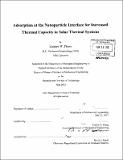| dc.contributor.advisor | Evelyn N. Wang. | en_US |
| dc.contributor.author | Thoms, Matthew W | en_US |
| dc.contributor.other | Massachusetts Institute of Technology. Dept. of Mechanical Engineering. | en_US |
| dc.date.accessioned | 2012-11-19T19:20:46Z | |
| dc.date.available | 2012-11-19T19:20:46Z | |
| dc.date.copyright | 2012 | en_US |
| dc.date.issued | 2012 | en_US |
| dc.identifier.uri | http://hdl.handle.net/1721.1/74946 | |
| dc.description | Thesis (S.M.)--Massachusetts Institute of Technology, Dept. of Mechanical Engineering, 2012. | en_US |
| dc.description | Cataloged from PDF version of thesis. | en_US |
| dc.description | Includes bibliographical references (p. 86-88). | en_US |
| dc.description.abstract | In concentrated solar power (CSP) systems, high temperature heat transfer fluids (HTFs) are responsible for collecting energy from the sun at the solar receiver and transporting it to the turbine where steam is produced and electricity is generated. Unfortunately, many high temperature HTFs have poor thermal properties that inhibit this process, including specific heat capacities which are half that of water. In an effort to enhance the effective heat capacity of these high temperature HTFs and thus increase the efficiency of the CSP systems, adsorption energy at the liquid-solid interface was investigated as a mechanism for increased thermal capacity. Solid ceramic nanoparticles were dispersed in several molten salts at 1-2% by mass with diameters ranging from 5 nm to 15 nm to provide a significant available surface area for adsorption at the particle-molten salt interface. After successful nanofluid synthesis, differential scanning calorimetry (DSC) was used to measure anomalous deviations from the expected heat capacity and enthalpy of fusion values in the nanofluids. The variation in the sensible and latent heat values was determined to be dependent on the presence of sub-100 nm particles and attributed to a layer of salt that remains adsorbed to the surface of the nanoparticles after the bulk of the salt has melted. The adsorbed salt layer is expected to desorb at a higher temperature, providing an increased effective thermal capacity in the vicinity of this desorption temperature. A thermal analysis technique utilizing DSC was proposed to approximate the thickness of the adsorbed layer at the liquid-solid interface, a value that has previously only been obtained using simulation or transmission electron microscopy. More specifically, the adsorbed layer of LiNO3 on Al2O3 particles was determined to be 5.3-7.1 nm thick, similar to the 1-3 nm layers that have been observed in literature for simple, monatomic fluids. The results provide new insight into the nature of adsorption at the liquid-solid interface in more complex fluid and particle systems that can be harnessed for enhanced thermal capacity in HTFs. | en_US |
| dc.description.statementofresponsibility | by Matthew W. Thoms. | en_US |
| dc.format.extent | 88 p. | en_US |
| dc.language.iso | eng | en_US |
| dc.publisher | Massachusetts Institute of Technology | en_US |
| dc.rights | M.I.T. theses are protected by
copyright. They may be viewed from this source for any purpose, but
reproduction or distribution in any format is prohibited without written
permission. See provided URL for inquiries about permission. | en_US |
| dc.rights.uri | http://dspace.mit.edu/handle/1721.1/7582 | en_US |
| dc.subject | Mechanical Engineering. | en_US |
| dc.title | Adsorption at the nanoparticle interface for increased thermal capacity in solar thermal systems | en_US |
| dc.type | Thesis | en_US |
| dc.description.degree | S.M. | en_US |
| dc.contributor.department | Massachusetts Institute of Technology. Department of Mechanical Engineering | |
| dc.identifier.oclc | 816562253 | en_US |
